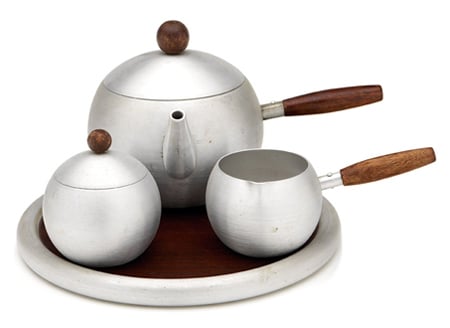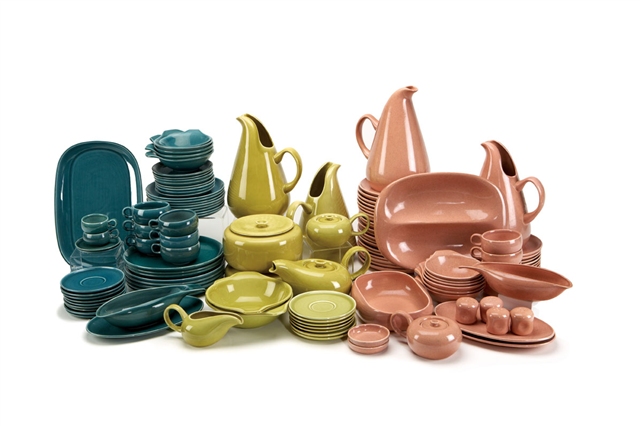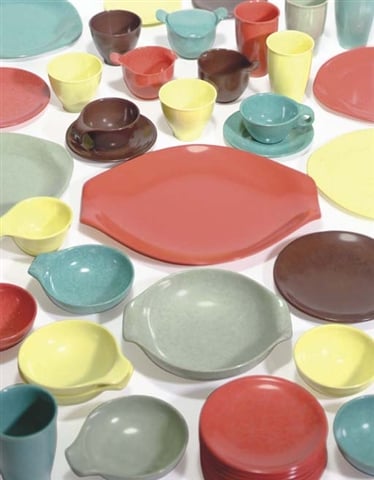Art World
Domestic Living Through Russel Wright
American Industrial designer, Russel Wright, revolutionized the American household.

American Industrial designer, Russel Wright, revolutionized the American household.

Amanda Lampard


Russel Wright, American modern dinner service (set of 191), 1937
During the 1930s, Modern Design was emerging around the world and finding its way into the American middle class home. The term “livable modernism” is used to describe a simplified aesthetic that could facilitate an enlightened lifestyle and the physical and psychological comfort of the user.1 Designers believed that through simple and affordable Design, the lives of American consumers would be improved.

Russel Wright, Coffee set (set of 6), c.1935a
Modern Design was simple, adaptable, and played with the notion of space saving in the home. Colonial revival furnishings were popular during the interwar years. In the early 1930s, these furnishings were a way to acknowledge the past and celebrate it by bringing it into the modern home. The spaces within the home were changing drastically in the 1930s. Domestic spaces became multifunctional, and very adaptable to the user’s current needs. This can be seen in the combination of a living room and a dining room. The furnishings in this type of room had to be interchangeable, lightweight, and multifunctional. Designers at this time focused on three Design properties that were efficient in the modern home. Modularity, lightness, and mobility were the key components for the Modern domestic interior.

Russel Wright, Flatware for the Metropolitan Museum of Art (set of 40), 1933
Russel Wright (American, 1904–1976) epitomized the concept of easier domestic living, and changed the American home. He began designing home furnishings with his wife Mary Wright (American, 1905–1952) in the early 1930s; the couple focused on how people were realistically living. Conant Ball of Massachusetts produced Wright’s line of furnishings, American Modern, in 1935. This line consisted of solid rock maple wood furniture that came in two finishes. The dark finish was for a traditional interior, while a light or “blonde” finish was for a M odern interior.2 The blonde finish was the more popular of the two finishes. Wright developed American Modern furnishings for the bedroom, dining room, and living room. The line offered a multitude of arrangements. The cushioned or rounded edges on the pieces were significant because they created an undulating line when the pieces were fitted tightly together.3

Russel Wright, Residential dinnerware (in 81 parts), 1953
The designer showcased the American Modern line at the Macy’s store in New York City. The nine-room furniture showcase featured different decorating styles; each room was compatible with the American Modern line. Through the department store, Wright was able to market his designs toward middle class Americans. He made Modern American Design affordable and obtainable to the masses. The American Modern name later lent itself to a line of earthenware and linens. The colorful and widely popular line of ceramic dinnerware was manufactured between 1939 and 1959 by Steubenville Pottery. Wright pioneered the idea of lifestyle-marketing during the 1930s to 1950s, and this is now used as a model for many of the popular lifestyle designers of today.

Russel Wright, Collection Spun Aluminum Table Articles (set of 130)
In 1950, Russel and Mary Wright published the Guide to Easier Living. The book proposed new ways of living for the American middle class family, and emphasized the concept of open plan living. The Guide to Easier Living changed the home and activities in the home. The concept of labor-intensive housework was replaced with “easy-to” solutions. This provided more time with the family and less time cleaning, cooking, and serving.
After World War II, the American family was moving out of the cities and into suburbs such as Levittown, NY, developed in 1947by Levitt and Sons. Americans were consuming more than ever and had time for leisure activities. With the transition to suburban areas, there was also the change in the household. Open plans and multifunctional living that Russel and Mary Wright were promoting was still evident in the American home during this period. The philosophies from Russel and Mary Wright’s Guide to Easier Living can still be found in many American households today.
Russel Wright’s designs are frequently found in a variety of auction houses around the world. Most recently, Wright’s works have appeared at auction houses such as Rago Arts and Auction Center,Leslie Hindman Auctioneers, Los Angeles Modern Auctions, Wright, and Treadway Toomey Galleries .
1 Kristina Wilson, Livable Modernism: Interior Decorating and Design During the Great Depression (New Haven: Yale University Press, 2004), 4.
2 Donald Albrecht, Russel Wright: Creating American Lifestyle (New York: Harry N. Abrams, 2001), 31.
3 Kristina Wilson, Livable Modernism: Interior Decorating and Design During the Great Depression (New Haven: Yale University Press, 2004), 31.